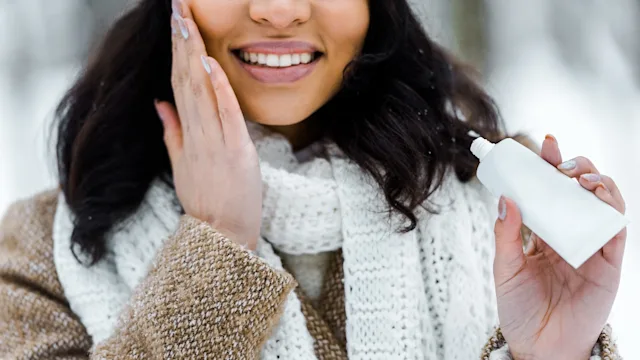Key takeaways:
Green tea can benefit your skin because it’s filled with a type of antioxidant called catechins, which may be especially powerful.
Research shows that green tea can help prevent skin cancer and treat genital warts. It may also help with oily skin, redness, acne, and eye puffiness.
To get the benefits of green tea for your skin, you can drink green tea, take green tea supplements, or apply skin creams with green tea extract.
Maybe you love drinking green tea because you enjoy its taste. Or perhaps you’re drawn to the beverage because you’ve heard that it has health-boosting qualities. Green tea is praised as a healthy drink or supplement with far-reaching benefits — from cancer prevention to better heart health. Some claim it can also help keep your skin healthy and glowing.
So, should green tea become a routine part of your skincare routine? Here we’ll review what the science says about green tea benefits for your skin.
Why is green tea therapeutic for skin?
Green tea is filled with antioxidants — molecules that can help protect cells from damage and aging. Both black and green tea are known to contain polyphenols, a type of antioxidant. But green tea is less processed than black tea, so it preserves more of its antioxidants.
Search and compare options
Green tea also has certain kinds of antioxidants — known as catechins — that may be especially powerful in preventing age-related damage. More than half of the catechins in green tea are a type called epigallocatechin-3-gallate (EGCG). EGCG seems to play a big role in the therapeutic effect of green tea on skin and overall health.
Lab studies have shown that EGCG can help lower inflammation, fight cancer, protect blood vessels, and reduce scar tissue. In short, it’s a powerful antioxidant. But researchers are still working to understand what this means for people who drink green tea or take supplements.
Scientists are also studying if adding green tea can help make skincare products more effective. Many cosmetic and skincare products have already started using catechins as an active ingredient.
Green tea benefits for skin
When it comes to skincare, it can be tricky to know just how helpful green tea is for your skin. Some of the studies looking at green tea are lab or animal studies. But research in humans is promising. Below are six potential benefits for your skin.
1. Acne and oily skin treatment
Green tea might help treat acne when it’s used topically or in oral form. There aren’t many studies on the topic, but the few that exist are positive.
One study found that people who took daily supplements with green tea extract for 4 weeks had fewer acne lesions on their nose, chin, and around their mouth. There’s some evidence that it can also help get rid of oily skin.
Green tea benefits: The antioxidants in green tea can help more than just your skin. It may help with anything from heart health to your mood.
Foods that are good for your skin: A dietitian researches the best foods and drinks to give you glowing skin.
Collagen supplements: Should you take collagen supplements for your skin? Research suggests it may be good for your skin, joints, and bones.
2. Inflammatory skin conditions
Green tea may help relieve skin changes that happen with certain inflammatory conditions. For instance, one study found that soaking in a bath of green tea can help relieve itching in children with eczema.
Animal research done with green tea also showed that topical treatment may help treat psoriasis and dandruff. This could be because it reduces the skin cell build-up that happens with both conditions. But there aren’t any clinical trials yet to show if this can work to treat psoriasis in humans.
3. Decrease redness
If you have red skin, green tea may help bring that redness down. A clinical trial revealed that a skincare product that combined green tea antioxidants with resveratrol and caffeine significantly reduced skin redness after a 6-week treatment.
Read more like this
Explore these related articles, suggested for readers like you.
4. Eye puffiness
There isn’t a lot of research about green tea and eye puffiness. But one small study found that adding green tea bags to an eye roll-on treatment helped decrease eye puffiness. The group that used green tea bags had less eye puffiness after 5 days of daily use. It’s possible that the caffeine plus tannins in green tea might help shrink blood vessels and reduce inflammation.
5. Reduce the risk of skin cancer
This is an area in which the evidence for health benefits is strongest. The EGCG in green tea helps prevent the DNA damage caused by ultraviolet (UV) light. Both topical creams and oral ingestion seem to lower the chances of getting skin cancer. One study found that people who drank 5 or more cups per week of green tea were less likely to develop skin cancer.
6. Genital warts
Green tea can work to fight against viruses like human papilloma virus (HPV), a common cause of genital warts. The catechins in green tea can stop some of the enzymes in HPV that cause warts. Green tea is such a powerful wart-fighter that the FDA approved a green tea ointment as a clinically proven treatment for genital and perianal warts. The ointment is called Veregen and it’s been on the market since 2006.
Health claims that lack evidence in humans
Some health claims seem promising in the lab but fail to show any effects in studies on humans. For now, there isn’t evidence that green tea is helpful in these cases.
Anti-aging
Green tea has been studied as a way to prevent photoaging. Photoaging refers to all the ways that UV light can damage the skin — like dark spots, wrinkles, and sagging skin. Research on cells and animals show that green tea can help prevent photoaging, but human studies haven’t shown evidence of this.
One study found that a supplement containing green tea could help decrease the effects of photoaging, but the supplement also contained many other ingredients. Clinical trials that focused on the effect of green tea supplements alone found that people who took green tea supplements didn’t show improvements in their skin after 2 months or even 2 years of use.
Wound healing
In the lab, the EGCG in green tea has been shown to help with wound healing. Some animal studies have also shown that it can help skin heal faster. But there aren’t many clinical trials, and the ones that have been done didn’t show the benefit of oral or topical green tea in humans. So at this time, there isn’t good evidence that it helps to treat skin wounds.
How can you use green tea for better skin?
You can use green tea for your skin in several different ways. You can:
Drink brewed green tea, cold or hot
Drink beverages that contain green tea extract
Ingest supplements with green tea extracts
Apply substances to your skin that contain green tea or ingredients from green tea
Bathe in water that has green tea added to it
Researchers are still learning about exactly which method — topical or oral — is best for the skin. And it might depend on what you’re trying to treat. For itchy or irritated skin, topical treatments seem to work best.
How much green tea should you drink for healthier skin?
There aren’t clear guidelines of exactly how often you should drink green tea if you’re looking to help your skin with one of the above conditions. But some studies showed benefits from drinking 5 cups per week of green tea. When it comes to supplements, there aren’t established dosing guidelines to know just how much of a dose is recommended.
There is also some evidence that adding milk and sugar to brewed tea could reduce the antioxidant power of the tea, although the research isn’t clear on this. It might depend on what kind of milk and how much milk and sugar you add. Chances are it won’t take away all the health benefits.
Can too much green tea be harmful?
A large review of 159 studies found that concentrated, catechin-rich green tea supplements could be linked to a rare side effect of liver damage. The risk was increased at higher doses or when the supplement was taken on an empty stomach. This review found that a dose of 338 mg per day of EGCG can be considered safe.
The review also found that ingesting green tea as brewed tea or extracts in beverages or food was unlikely to lead to any liver problems. According to The National Center for Complementary and Integrative Health (NCCIH), drinking up to 8 cups of green tea per day is thought to be safe. Pregnant people shouldn’t drink more than 6 cups of green tea per day.
But keep in mind that excessive amounts of caffeine or sugar aren’t great for your overall health, or your skin.
What are the other benefits to drinking green tea?
Green tea has been studied for possible health benefits that extend beyond your skin. It’s possible that green tea might help with:
Heart health
Cancer prevention
Blood sugar control in people with diabetes
Brain health
Symptoms of digestive conditions like inflammatory bowel disease
The bottom line
Green tea has been enjoyed for its taste and health benefits for centuries. The latest scientific research seems to suggest that the antioxidant-rich green tea holds promise for improving your skin in more ways than one. Some effects of green tea — like reducing your skin cancer risk or treating warts — are well-validated by the evidence. Other possible benefits — like anti-aging or wound healing — show promise in the lab but may not have the same effects in humans. If you’re interested in seeing if green tea can be helpful for you, you can start by brewing yourself a cup of tea. It can be a relaxing ritual that may also lead to healthier skin.

Why trust our experts?


References
Abellanoza, I. I. S., et al. (2010). The effect of commercially prepared lipton Camellia sinensis (green tea) in the reduction of the severity of eye bag puffiness among selected call center agents in Qualfon, Philippines Inc.: Basis for information dissemination as a potential adjunctive therapy for eye bag puffiness. Health Research and Development Information Network.
Chacko, S. M., et al. (2010). Beneficial effects of green tea: A literature review. Chinese Medicine.
Chiu, A. E., et al. (2005). Double-blinded, placebo-controlled trial of green tea extracts in the clinical and histologic appearance of photoaging skin.
C.P.M. Contract Pharma GmbH & Co. KG. (2008). Veregen (sinecatechins) ointment [package insert].
Di Sotto, A., et al. (2022). Efficacy and safety of oral green tea preparations in skin ailments: A systematic review of clinical studies. Nutrients.
Ferzli, G., et al. (2013). Reduction of facial redness with resveratrol added to topical product containing green tea polyphenols and caffeine. Journal of Drugs in Dermatology.
Granger, C., et al. (2020). Prospective evaluation of the efficacy of a food supplement in increasing photoprotection and improving selective markers related to skin photo-ageing. Dermatology and Therapy.
Honigbaum, A., et al. (2017). Green tea and nonmelanoma skin cancer: Is there an association? Journal of the American Academy of Dermatology.
Hu, J., et al. (2018). The safety of green tea and green tea extract consumption in adults – Results of a systematic review. Regulatory Toxicology and Pharmacology.
Janjua, R., et al. (2009). A two-year, double-blind, randomized placebo-controlled trial of oral green tea polyphenols on the long-term clinical and histologic appearance of photoaging skin. Dermatologic Surgery.
Kanlayavattanakul, M., et al. (204). Recent insights into catechins-rich Assam tea extract for photoaging and senescent ageing. Scientific Reports.
Katiyar, S. K. (2011). Green tea prevents non-melanoma skin cancer by enhancing DNA repair. Archives of Biochemistry and Biophysics.
Kim, H. S., et al. (2014). New insights into the mechanisms of polyphenols beyond antioxidant properties; lessons from the green tea polyphenol, epigallocatechin 3-gallate. Redox Biology.
Lim, J. Y., et al. (2014). Protective effect of the standardized green tea seed extract on UVB-induced skin photoaging in hairless mice. Nutrition Research and Practice.
Lu, P. H., et al. (2016). Does supplementation with green tea extract improve acne in post-adolescent women? A randomized, double-blind, and placebo-controlled clinical trial. Complementary Therapies in Medicine.
Medical College of Georgia. (2007). Green tea holds promise as new treatment for inflammatory skin diseases. ScienceDaily.
Meetham, P., et al. (2018). Development and clinical efficacy evaluation of anti-greasy green tea tonner on facial skin. Revista Brasileira de Farmacognosia.
Mita, S. R., et al. (2024). A recent update on the potential use of catechins in cosmeceuticals. Cosmetics.
Mokra, D., et al. (2023). Therapeutic effects of green tea polyphenol (‒)-epigallocatechin-3-gallate (EGCG) in relation to molecular pathways controlling inflammation, oxidative stress, and apoptosis. International Journal of Molecular Sciences.
National Center for Complementary and Integrative Health. (2020). Green tea. U.S. Department of Health and Human Services.
Naumovski, N., et al. (2019). The association between green and black tea consumption on successful aging: A combined analysis of the ATTICA and MEDiterranean ISlands (MEDIS) epidemiological studies. Molecules.
Peluso, I., et al. (2017). Antioxidants from black and green tea: From dietary modulation of oxidative stress to pharmacological mechanisms. British Journal of Pharmacology.
Rashidinejad, A., et al. (2017). Addition of milk to tea infusions: Helpful or harmful? Evidence from in vitro and in vivo studies on antioxidant properties. Critical Reviews in Food Science and Nutrition.
Saric, S., et al. (2017). Green tea and other tea polyphenols: Effects on sebum production and acne vulgaris. Antioxidants.
Sharma, P., et al. (2019). Tea polyphenols for the prevention of UVB-induced skin cancer. Photodermatology, Photoimmunology and Photomedicine.
Sitepu, N. F. (n.d.). The effect of green tea (Balneotherapy) towards atopic dermatitis in Asahan, Indonesia. Asian Academic Society International Conference Proceeding Series.
Tyring, S. K. (2012). Sinecatechins. Journal of Clinical and Aesthetic Dermatology.
Xu, F. W., et al. (2021). Beneficial effects of green tea EGCG on skin wound healing: A comprehensive review. Molecules.


















